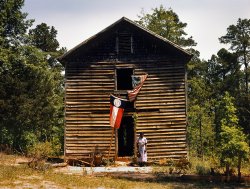
MAY CONTAIN NUTS

Search Shorpy
SHORPY ART

Framed or unframed, desk size to sofa size, printed by us in Arizona and Alabama since 2007. Explore now.
Join and Share
Ad-Free Shorpy
Shorpy is funded by you. Patreon contributors get an ad-free experience.
Learn more.

Recent comments
- Texas Flyer wanted
- Just a Year Too Soon
- WWII -- Replacing men with women at the railroad crossing.
- Yes, Icing
- You kids drive me nuts!
- NOT An Easy Job
- I wonder
- Just add window boxes
- Icing Platform?
- Indiana Harbor Belt abides
- Freezing haze
- Corrections (for those who care)
- C&NW at Nelson
- Fallen Flags
- A dangerous job made worse
- Water Stop
- Passenger trains have right of way over freights?
- Coal
- Never ceases to amaze me.
- Still chuggin' (in model form)
- Great shot
- Westerly Breeze
- For the men, a trapeze
- Tickled
- Sense of loneliness ...
- 2 cents
- Charm City
- What an Outrage
- Brighton Park
- Catenary Supports
Member Photos
The Shorpy
Print Emporium
Print Emporium
Search Shorpy
Search results -- 30 results per page
- Greene County: 1941
- ... View full size. 35mm Kodachrome transparency by Jack Delano.
Dignity! I saw scenes like this in the late 40s, after the war, ... Posted by Dave - 09/08/2011 - 9:38pm -
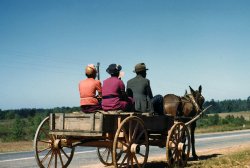
- Routing the Rails: 1943
- ... Yard, Chicago, Ill." 4x5 inch Kodachrome transparency by Jack Delano for the Office of War Information. View full size.
Past blasting ... Posted by Dave - 05/15/2016 - 11:40pm -
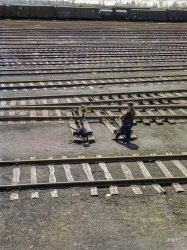
- On the Waterfront: 1941
- ... View full size. 4x5 Kodachrome transparency by Jack Delano.
The Boat Looks like they're careening the boat at pierside. ... Posted by Dave - 08/30/2012 - 12:03pm -
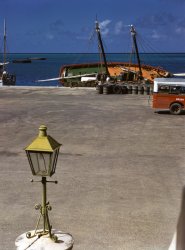
- Drugstore Dishes: 1941
- ... Investment Pharmacy, Washington, D.C." Acetate negative by Jack Delano for the Farm Security Administration. View full size.
Cunning ... Posted by Dave - 01/16/2019 - 6:39pm -
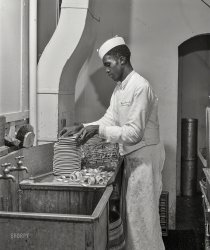
- Atlanta Empress: 1941
- ... County, Georgia." Medium format acetate negative by Jack Delano for the FSA. View full size.
What does she see? Oh, I want to ... Posted by Dave - 11/07/2018 - 12:39pm -
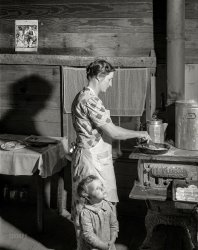
- Family History: 1941
- ... Conservation Corps camp." Medium format negative by Jack Delano. View full size.
Eyes have it No doubt about the relation. ... Posted by Dave - 02/21/2019 - 6:24pm -
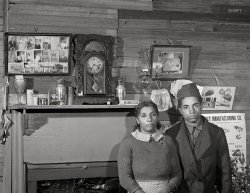
- Robert Hill: 1943
- ... and Santa Fe Railroad." Medium-format nitrate negative by Jack Delano, Office of War Information. View full size.
Wonderful portrait ... Posted by Dave - 06/25/2009 - 1:57am -
![Robert Hill: 1943 March 1943. "Topeka, Kansas. Robert L. Hill, steel car repairer and rivet driver, at the car shops of the Atchison, Topeka and Santa Fe Railroad." Medium-format nitrate negative by Jack Delano, Office of War Information. View full size.
Wonderful portraitI'd echo allie's sentiments. Mr. Hill's handsome, dignified face and bearing reveal something about his character, at a time when many of his countrymen regarded him as a second-class citizen.
I hope this image has been copied to a more stable and durable medium, for posterity, than the nitrate it was captured on.
[These images have all been copied and preserved by digitization. - Dave]
CastingSamuel L. Jackson will play him in the movie.
What a portrait!I hope Mr. Hill's grandchildren have copy of this photograph. It is such a beautiful image of this gentleman. My grandfather was a welder, but passed away before I was born. The only photos I have of him are of a frail old man. I would love a photo of him in his prime, like this one.
RivetingI love this man's face. It's a face of courage and a proud dignity. I would have liked to have known him.
Robert L. Hillhttp://en.wikipedia.org/wiki/Robert_L._Hill
Same name, born 1892 in Arkansas, fled to Kansas and worked in a meat plant in Topeka.....
Could this be Robert Jr.?
Heck, if he is 51 this is Robert Sr.!
Robert Hill -- 1940 US CensusRobert Hill, born about 1900 in Arkansas, was married to a Mattie (born about 1903, in Arkansas).
Five children, two boys named Wilson (age 17, born in Kansas) and Earl (13, born in Kansas), and two daughters, Viola (age 21, born Arkansas), and Georgia (age 19, born in Kansas). There's an infant named Winifred, age 2 months, listed in the household. Her relationship is not stated, but as she's listed directly under Viola, it's probably her daughter, making her Robert's granddaughter.
They lived at 608 East 18th Street in Topeka, and owned their own home (value $1,200). Robert earned $1,728 in 1939 ($28,000-$29,000 adjusted for inflation to 2013 dollars), making him by far the best paid man on his census page.
Employer is listed as the Santa Fe Railroad, of course, his occupation "Machine Labor".
(The Gallery, Jack Delano, Railroads)](https://www.shorpy.com/files/images/8d26557u.thumbnail.jpg)
- Charlton Street: 1941
- ... Charlton Street, Savannah, Georgia." Acetate negative by Jack Delano for the Farm Security Administration. View full size.
Still ... Posted by Dave - 11/23/2018 - 3:36pm -
![Charlton Street: 1941 April 1941. "Row of houses on East Charlton Street, Savannah, Georgia." Acetate negative by Jack Delano for the Farm Security Administration. View full size.
Still looking good
Curb AppealAll I can say is WOW!
A truly beautiful revival. That Google Street View provides a powerful argument for renovating rather than razing neighborhoods. Thanks for posting.
It had better look goodEstimated value of this address is $790,000. Beautiful property, though, and I'd bet we're not the only ones glad it was spared from the wrecking ball. One other interesting thing about this district is that it indicates that the area is not "hollowed out" in the way that older neighborhoods in Detroit, Gary, and Chicago are. In those cities, you see tons of vacant lots where houses ought to be; it would be interesting to learn that didn't happen in Savannah.
[Savannah, like Charleston and New Orleans, is rather famously well-preserved. - Dave]
(The Gallery, Jack Delano, Savannah)](https://www.shorpy.com/files/images/SHORPY-8c05217a.thumbnail.jpg)
- A Bird in the Pan: 1943
- ... a hill of beans, and thou. Medium format negative by Jack Delano for the Office of War Information. View full size.
Thought ... Posted by Dave - 11/22/2017 - 1:40pm -
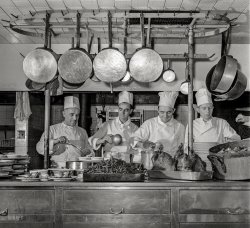
- I Enjoy Being a Girl: 1941
- ... kitchen near Burlington, Vermont." Acetate negative by Jack Delano for the Farm Security Administration. View full size.
Is it Itt? ... Posted by Dave - 01/29/2019 - 10:30am -
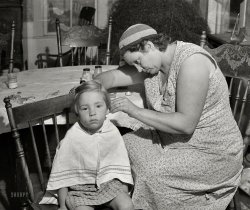
- Stares & Stripes: 1941
- ... near Fort Bragg, North Carolina." Acetate negative by Jack Delano. View full size.
Santa's elf What in the world kind of ... Posted by Dave - 12/10/2018 - 12:29pm -
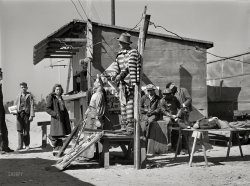
- Fanny Parrott: 1941
- ... Siloam, Greene County, Georgia." Medium format negative by Jack Delano. View full size.
Calendars indicate 1943 The insurance ... Posted by Dave - 07/11/2018 - 9:58pm -
![Fanny Parrott: 1941 May 1941. "Mrs. Fanny Parrott, wife of former slave near Siloam, Greene County, Georgia." Medium format negative by Jack Delano. View full size.
Calendars indicate 1943The insurance calendar appears to be dated 1943 and the Watkins calendar indicates January 1st is a Friday which is 1943.
[The insurance calendar is for February 1940. The Watkins calendar is from 1937. And on the left we have a 1941 almanac. - Dave]
Watkins productsI see she has a Watkins calendar. Watkins Products (seasonings and extracts, soaps and detergents, cough and cold remedies, liniment, etc.) were sold by traveling salesmen. I can remember the Watkins man stopping by my grandparents' house in East Texas, when I was spending summers there in the 1960s. Founded in 1868, Watkins is still around today.
Stand CorrectedThe zoom in on the calendar really helped.
(The Gallery, Jack Delano, Portraits)](https://www.shorpy.com/files/images/SHORPY-8c05583a1.thumbnail.jpg)
- Night Train: 1943
- ... & Santa Fe yard at night." Medium-format negative by Jack Delano. View full size.
2-10-2 "Santa Fe Type" The Santa ... Posted by Dave - 01/07/2013 - 3:46pm -
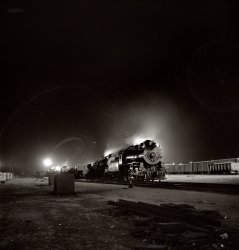
- Crossing Guard: 1943
- ... Seligman, Arizona, and Needles, California." Photo by Jack Delano. View full size.
How in the world can you tell this is a ... Posted by Dave - 06/12/2014 - 5:05pm -
![Crossing Guard: 1943 March 1943. "Topock, Arizona (vicinity). Military sentry stationed at a bridge over the Colorado River along the Santa Fe Railroad between Seligman, Arizona, and Needles, California." Photo by Jack Delano. View full size.
How in the worldcan you tell this is a shotgun? What software are you using to blow up this picture?
[Distinctive profile. -tterrace]
He Means BusinessSomething you don't often see in pictures. The guard is armed with a pump shotgun, probably either a Model 1897 or a Model 12. Most often you'll see soldiers on guard duty armed with an M1 or occasionally with M1903. There may have been other guards here armed with rifles to deter saboteurs at a distance, but this guy is ready for close-in defense.
Sentry duty shotgunI think the guard is armed with a pump action shotgun. I've read that shotguns were often used on various guard and protection details during the war.
Red Rock BridgeThis is Santa Fe's Red Rock Bridge, completed in 1890, and due to be replaced with a new bridge just two years after this photo was made. This then became the US 66 bridge for another 20 years. More here.
Hot DutyThe last time I was in Needles, the temerature was 119 degrees. I felt like I was going to die walking between my air conditioned car and the air conditioned gas station. This is not the place where you want to be standing outside in battle fatigues and a steel helmet. This poor soldier may have screwed up somewhere else in order to draw this grueling duty.
6 Rails Across the BridgeWhy 6 rails across the bridge?
Gantlet track.
There is double track on each side of the bridge, which was built when a single track was sufficient for the traffic on the line. Traffic increased to where it became necessary to double track the line, but as a cost savings the bridge, only wide enough for a single track, was retained. Rather than put switches at each end of the single track segment, the bridge was laid with gantlet track. The two rails of each of the tracks for each direction were merged together about 6" apart.
Counting from the left, the first and fifth rails are for trains in the approaching direction. The second and sixth for trains moving away from the photographer (as in, the caboose seen beyond the bridge.) The two center rails are guard rails, as a safety measure common on all bridges in case of derailment.
My Two PelletsCall me a scatterhead, but that barrel looks too thin to be a scattergun barrel. In other words, it's hard to gauge but it seems too thin to be a shotgun barrel. AFAIK sentry duty shotguns in WWII were 12 gauge. That barrel looks no bigger than a .410, if that.
I think I figured it outIt's a .30 cal. Springfield shotgun.
Light And DistanceI'm no expert in photography, but I'd say the reason the barrel looks so thin is because of the effect of light, background and distance on a cylindrical surface. I've seen this before on items much closer. By the way, the barrel has been shortened to 18 to 20 inches, just right for up close shooting. I don't know if this was factory done or done by an armorer in the field. After looking at it more, I'm also not sure it's a Model 12 or a '97. The forearm looks a little fat for those. Could be a Mossberg.
[Here's a closeup. -tterrace]
Three pumpsI can't find a record of any Mossberg shotgun being used by the US military in WW II, so the choices are:
Winchester M1897, Winchester M12, Remington M31
The picture (on screen, at least) is too bad to tell for certain. If I had to guess I'd say it was the 1897. If it's possible to see the receiver and grip on a high quality print, one can tell for certain. The M1897 has an exposed hammer and a flatter, longer grip section than the M12 between the receiver and the top of the stock. The M12 and M31 are easy to tell apart.
The Browning Auto 5 was also used, but the weapon in the picture is definitely not one of those.
(The Gallery, Boats & Bridges, Jack Delano, Railroads)](https://www.shorpy.com/files/images/SHORPY-8d27444a.thumbnail.jpg)
- Fayetteville: 1941
- ... start coming out at Fort Bragg." Medium format negative by Jack Delano for the Farm Security Administration. View full size.
Merry ... Posted by Dave - 12/25/2018 - 11:40am -
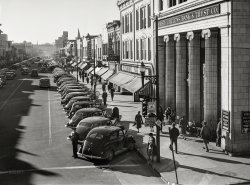
- Cornerman: 1943
- ... Group relaxing in his hutment." Medium-format negative by Jack Delano for the Office of War Information. View full size.
"Squared ... Posted by Dave - 12/04/2016 - 7:02pm -
![Cornerman: 1943 July 1943. Greenville, South Carolina. "Air Service Command. Enlisted man of the 25th Service Group relaxing in his hutment." Medium-format negative by Jack Delano for the Office of War Information. View full size.
"Squared Away"That young Airman has his corner of the hut neat & tidy, or as they say in the Military "squared away".
One thing that surprises me is that he appears to have 4 pairs of shoes. I wouldn't have thought they would have had that many pair in those days.
America's "Greatest Generation", not many of them left these days. God bless them all.
Two WordsPalmetto Bugs. My dad was stationed in the South at one point during WWII - the Palmetto Bugs were legendary.
About Those ShoesOur airman is wearing a pair of Brogans, an ankle high boot that was regular issue to Army personnel at the time. He also has a standard pair of boots under his bunk on the left, along with a standard pair of Army issue low quarter shoes (on the right). In the middle is a pair of shoes only Air Corps members were allowed to wear, wing tips! Like all low quarter shoes, they were only worn with the Class A uniform or any other off post, non-combat uniform combination.
Palmetto bugs?The south's euphemism for giant freaking cockroaches, and plenty of them!
The windowsI find the configuration of the two open windows very intriguing, never having seen this kind of window opening before. I must presume that the slot & pin arrangement allows the window to be the most fully open for maximum airflow yet still giving some protection from unexpected rain (which frequently falls at night when cooler airs are more commonplace) allowing our airman to sleep as peacefully as possible. Very nice, great photo. BTW - are those two little glue pots on the shelf?
[I think you're right. -tterrace]
(The Gallery, Jack Delano, WW2)](https://www.shorpy.com/files/images/SHORPY-8d32031a.thumbnail.jpg)
- Cats and Dolls: 1940
- ... FSA clients." Farm Security Administration photo by Jack Delano. View full size.
Halloween in December I love the old black ... Posted by Dave - 11/16/2018 - 11:55am -
![Cats and Dolls: 1940 Dec. 1940. Portsmouth, Rhode Island. "Mrs. Botello and her sister, Portuguese FSA clients." Farm Security Administration photo by Jack Delano. View full size.
Halloween in DecemberI love the old black cat head Halloween decorations on the mantle. I have a reproduction of one very similar to them on my own mantle!
[That ledge over your fireplace is a mantel, not a "mantle." - Dave]
Correct name?Since they are Portuguese, the surname is most likely Botelho.
Botello or Botero?Could have sworn these were the original Botero Sisters!
(The Gallery, Cats, Jack Delano, Kids)](https://www.shorpy.com/files/images/SHORPY-8c04215a.thumbnail.jpg)
- Troop Train: 1943
- ... Topeka & Santa Fe between Belen and Gallup." Photo by Jack Delano for the Office of War Information. View full size.
Long & ... Posted by Dave - 06/17/2014 - 6:55am -
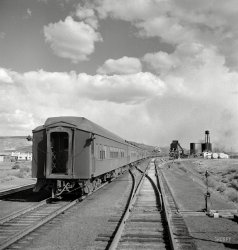
- Dr. Smock: 1941
- ... Union Point, Greene County, Georgia." Acetate negative by Jack Delano for the Farm Security Administration. View full size.
Medical ... Posted by Dave - 12/12/2018 - 11:09pm -
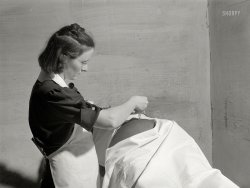
- Freedom: 1941
- ... boy in Freedom, Pennsylvania." Medium format negative by Jack Delano for the Farm Security Administration. View full size.
Way back ... Posted by Dave - 12/23/2018 - 10:10am -
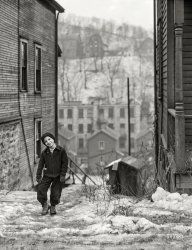
- Where I'm Coming From: 1943
- ... en route to Clinton. Medium-format nitrate negative by Jack Delano for the Office of War Information. View full size.
Romance of ... Posted by Dave - 03/24/2017 - 6:32pm -
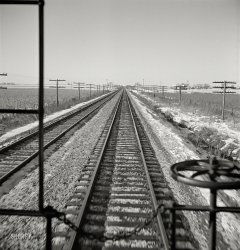
- Sign of the Cross: 1940
- ... Camden, North Carolina." Medium format acetate negative by Jack Delano for the Farm Security Administration. View full size.
Pie the ... Posted by Dave - 04/30/2021 - 1:23pm -
![Sign of the Cross: 1940 July 1940. "Negroes from Florida and Georgia who travel by car and truck, following the potato crop northward. Migratory agricultural worker has his supper (a nickel pie and a glass of milk) at the railroad crossing at Camden, North Carolina." Medium format acetate negative by Jack Delano for the Farm Security Administration. View full size.
Pie the wayThe young fellow in the foreground looks as if he's posing for an advertisement. His pose, his face, the pie and the milk - - they combine to look as if they are tempting the viewer to indulge, although I'm unsure if the ad would be for milk or pie. By the way, that's a generous slice of pie for a nickel.
[A "nickel pie" is an entire small pie, not a slice. - Dave]
Locomotive TireThat heavy ring protecting the crossing signal is a worn out steam locomotive tire.
Locomotive tires were heated with a circular gas burner to expand them, then shrunk onto the cast driver center. They tended to wear to a hollow tread contour rather than the correct slightly conical surface, which should have a specific fillet radius to the flange. Every time a locomotive spun its wheels, the tires were wearing out of contour.
The tires could be turned a couple times, like brake disks or brake drums, but then were discarded to be melted down. This one escaped the furnace, and makes a nice seat, although usually too hot or too cold.
Also interesting how little grade crossing signals have changed in 81 years.
Model railroaders, take note!
(The Gallery, Agriculture, Jack Delano, Railroads)](https://www.shorpy.com/files/images/SHORPY-8c02723a.thumbnail.jpg)
- Philly Up: 1943
- ... Company service stations in Philadelphia." Photo by Jack Delano, Office of War Information. View full size.
Eveready Dodge ... Posted by Dave - 03/30/2017 - 5:03pm -
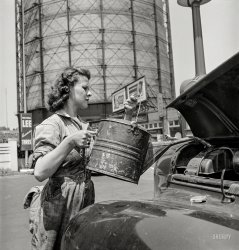
- The Hills Have Holes: 1940
- ... ovens in background." Medium format acetate negative by Jack Delano for the Farm Security Administration. View full size.
Left twix ... Posted by Dave - 10/31/2018 - 3:35pm -
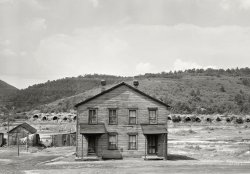
- Green: 1941
- ... of Cayey." Medium format Kodachrome transparency by Jack Delano, Office of War Information. View full size.
(The Gallery, ... Posted by Dave - 03/06/2019 - 11:35am -
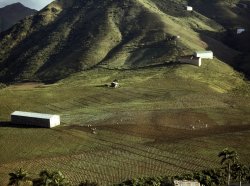
- Cloud Mountain: 1943
- ... where the railroad gets its rock for ballast." Photo by Jack Delano, Office of War Information. View full size.
Belen Harvey House ... Posted by Dave - 11/15/2013 - 8:14am -
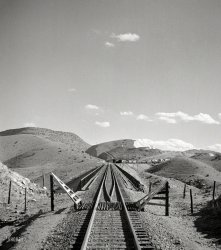
- The Gleaners: 1940
- ... digger on a farm near Caribou, Maine." Acetate negative by Jack Delano. View full size.
At least we now know the front tractor plate ... Posted by Dave - 11/25/2018 - 4:49pm -
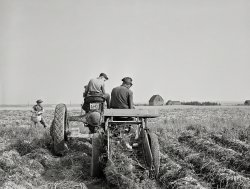
- Down to Belen: 1943
- ... There is a drop of over 1600 feet in elevation." Photo by Jack Delano. View full size.
Riding the yellow The 45 degree blade of the ... Posted by Dave - 10/11/2013 - 4:04pm -
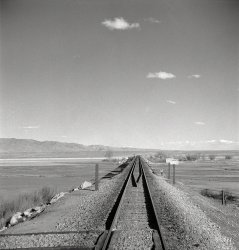
- Human Freaks: 1941
- ... Vermont." Next up: Boko the "Alligator Skin Boy." Photo by Jack Delano. View full size.
The Snow Sisters It looks like Elvira Snow ... Posted by Dave - 01/13/2019 - 5:20pm -
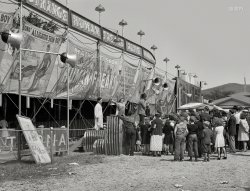
- White Plains: 1941
- ... flying the U.S. and Georgia colors, is attributed to Jack Delano although it bears the notation "Possibly photographed by Marion Post ... Posted by Dave - 08/30/2012 - 12:00pm -
